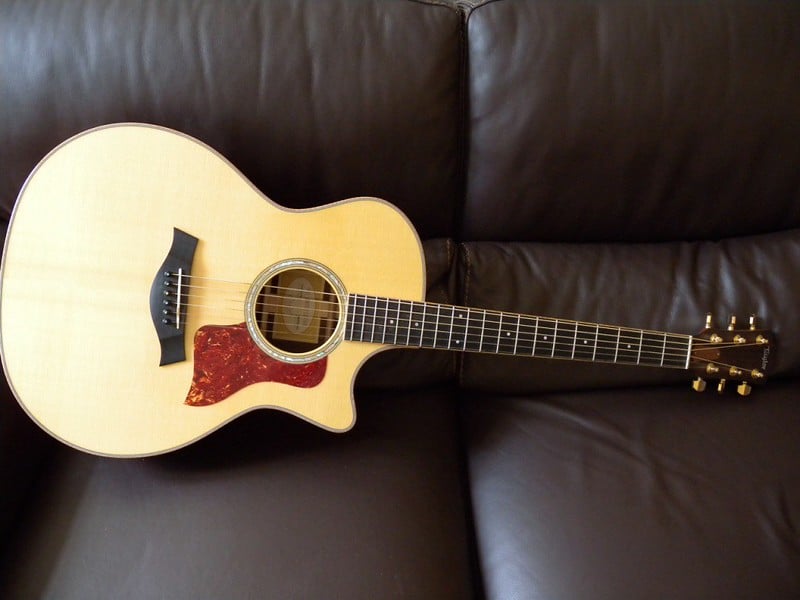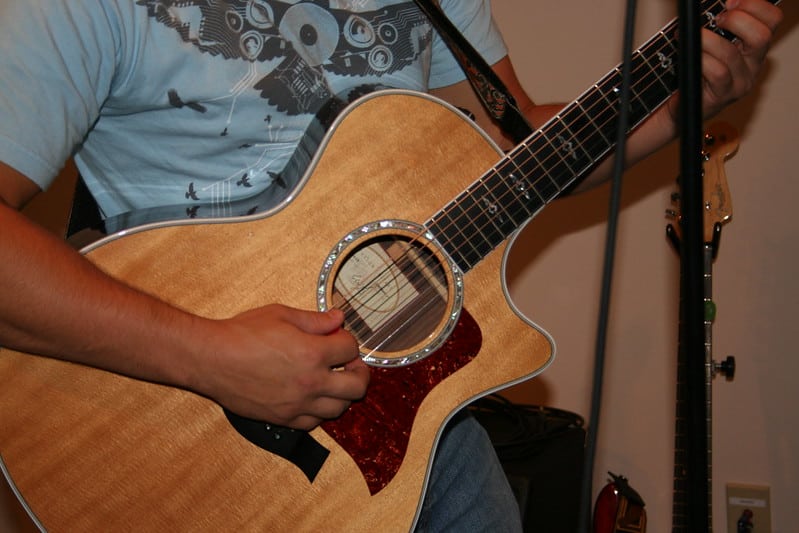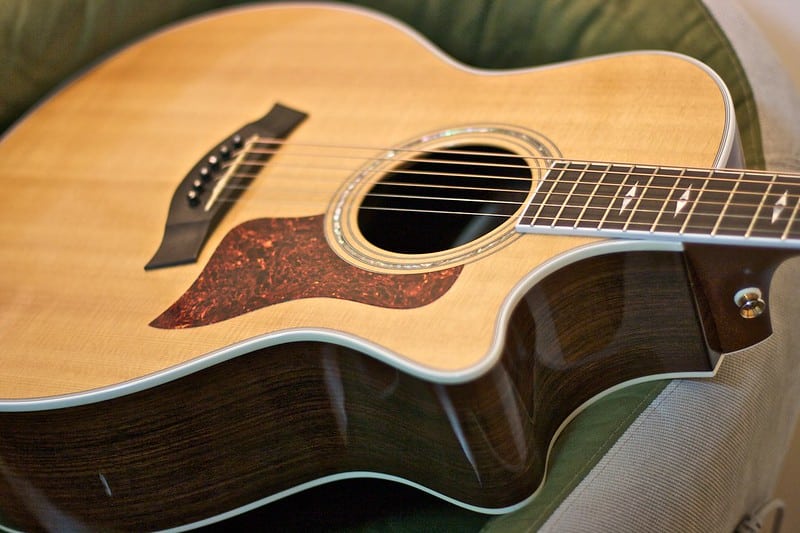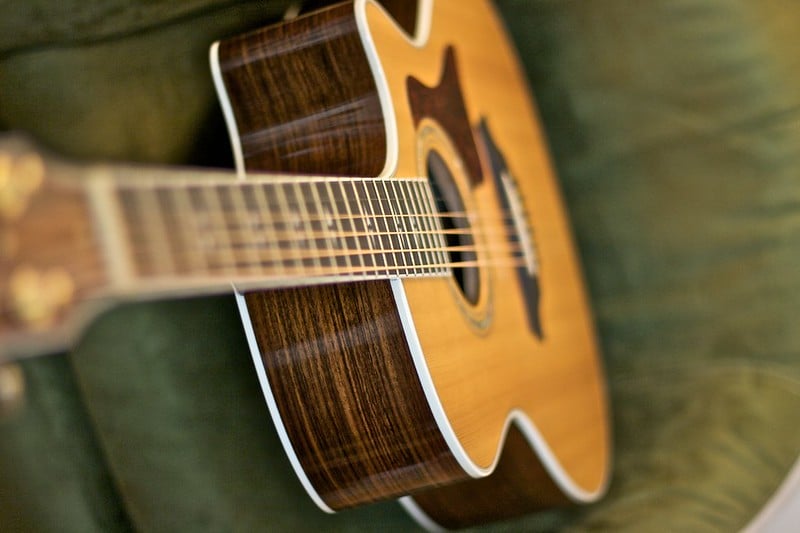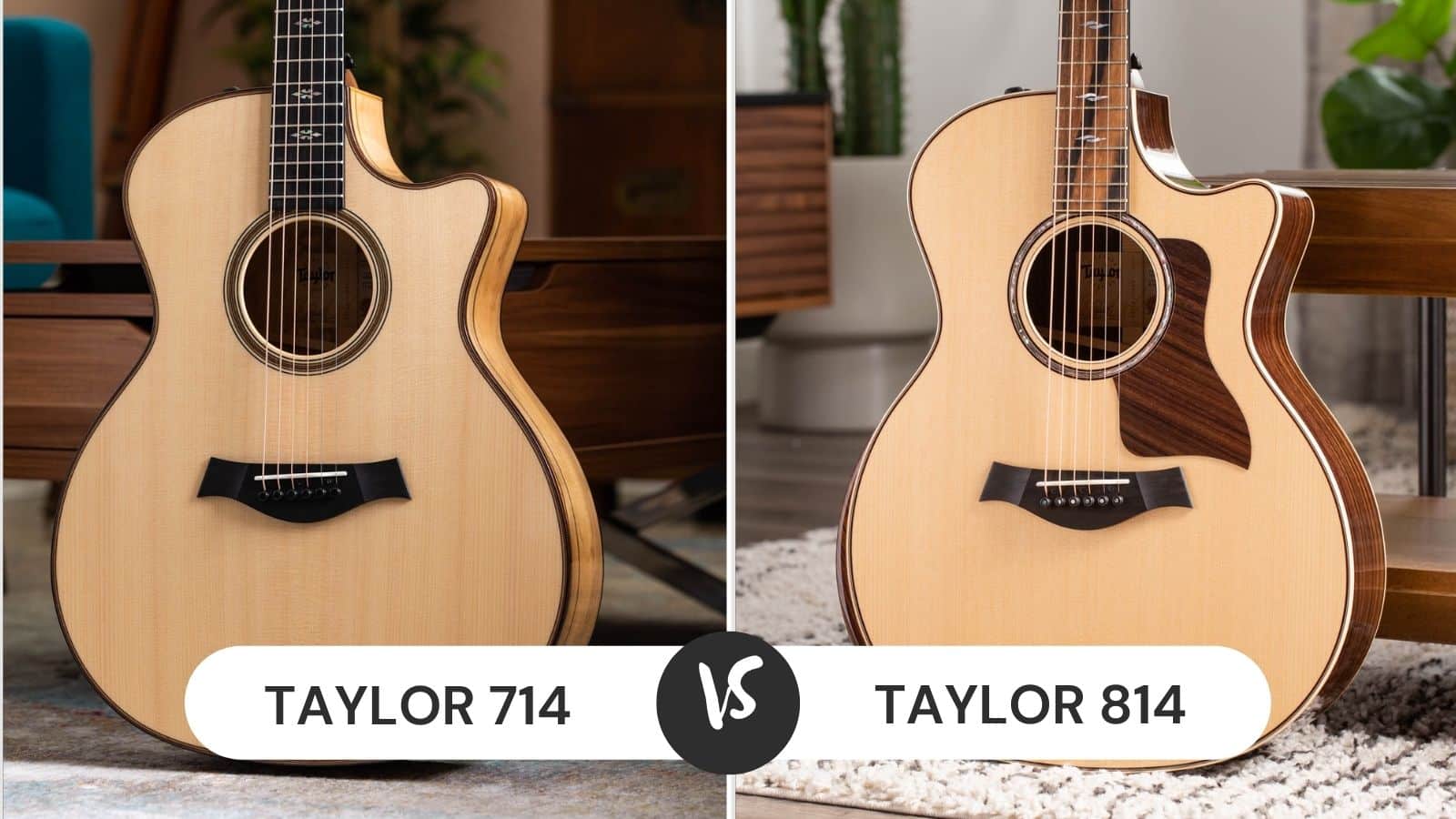
Taylor is a well-known brand and has an exceptional range of acoustic and electric guitars.
Since there is a huge variety of guitars available, it gets hard to choose one. Ideally, it’s best to consider the build quality and type of music a guitar can produce.
For this reason, we are talking about Taylor 714 and Taylor 814 as these two are high-end acoustic guitars with amazing sound output. Now, let’s have a look at the differences!
Taylor 714 vs 814 Comparison
| Taylor 714 | Taylor 814 | |
|---|---|---|
| Top wood | Lutz spruce | Sitka spruce |
| Neck | Tropical mahogany construction | Tropical mahogany construction |
| Radius | 14 inches | 15 inches |
| Binding | Non-figured koa | Non-figured maple |
Taylor 714
This guitar has been around since 1974 and has become the most leading and premium acoustic guitar. The guitar is designed to create a clear and bright sound and is made with an inventive tonewood selection.
In addition, it has a modern appearance. It has pure Taylor-like aesthetics since there is a Lutz spruce wood top and has intricate details in the build. Overall, it promises an all-rounded performance.
1. Design
The guitar has been designed with the Lutz spruce wood top, which is known as the natural hybrid of White spruce wood and Sitka wood.
To illustrate, the White spruce wood promises smoother quality and low density while Sitka adds the projection and stiffness, which promises amazing sound quality and durability.
The guitar’s sides and back are made from Indian rosewood, which creates warm and vintage sound quality.
The guitar is integrated with a twenty-fret fretboard that’s made from African ebony material and is installed over the mahogany neck. In addition, it’s integrated with V-class bracing, which means the top will be in tune with the vibrating strings.
As a result, the sound interference will be eliminated, leading to in-tune and consistent sound. In simpler words, V-class bracing balances the sustain and volume better as compared to X-shape bracing. In addition, it improves intonation across the fretboard.
The guitar has a simple and no-frills design. It’s safe to say that the guitar has a refined style with top-notch hardware. There is a black graphite nut and a Micarta-based saddle.
There are standard nickel tuners in the guitar, which promise higher tuning stability and improve the string changes.
Moreover, there is an ES-2 pickup with an under-saddle design and easier onboard controls integrated on the upper bout. In simpler words, it has a solid build that provides value for money.
The guitar’s body is fully bound with koa, which adds a premium touch. In addition, the soundhole and edge trims are made from herringbone Douglas, promising effective packaging.
2. Sound
The guitar is popular for its articulate and clean voice which has booming lows and crispy highs – the highs are contemporary and there is a relaxed midrange.
It has electric guitar-like playability, which promises consistent sound output. It has a balanced sound output and promises dynamic response and range in the music.
The best thing about this guitar is that it belts out in case it’s strummed and promises reliable sound quality even if it’s fingerpicked.
Since it has a wider dynamic range, the guitar promises louder sound output. Moreover, the sound has more depth and clarity. In simpler words, the guitar produces clean sound in the low mids but the high registers promise a free and less muffled ring.
In addition, it has a subtle intonation, resulting in in-tune, smoother, and slightly sweeter sound quality. There is a Peterson strobe tuner as well, which helps tune in smooth sound while playing through difficult intervals.
It has stunning articulation and a crystal top end. In addition, it has amazing tonal projection as well as rich and open bass. The availability of the Lutz spruce wood top promises dynamic playability and you can smoothen the soft sounds.
This guitar works the best with ES-2 pickup as it helps transmit acoustic signals. Similarly, there will be no compression in the audio and you don’t need to worry about the electronic dampening that acoustic pickups are popular for.
Overall, this guitar wins in every category as it delivers premium music quality, high-end tones, and sublime playability. However, these features and build quality lead to a higher price point.
Taylor 814
The guitar is known for its grand-auditorium body and is popular for its low-end depth, which promises high-end sound production as you get from bigger guitars.
In addition, it has a shallow and low action configuration along with a half-rounded neck, promising easier and faster bending of the notes.
In simpler words, this guitar is extremely effortless to play with, and when you hit its strings, it promises a higher response. This guitar has been around since 1994, and over the years, the company has refined the construction techniques.
1. Design
Over the past few years, multiple cosmetic and construction changes have been done to the guitar. For instance, the first model had a rosewood headstock but the latest version has a headstock made from black ebony with gloss finishing.
There is maple binding around the guitar body’s edges, fingerboard, and head. Overall, the design is pretty simple. The ebony-based fingerboard is streaked and looks smoky.
There are element inlays, which help personalize the guitar and orientate the fretboard. The soundhole is produced from rosette wood and there is an abalone center along with maple edges to create a durable design.
There are purfling edges on the guitar with rosewood that helps protect the edges and add stability to the structure. The guitar has been integrated with a diagonally streaked rosewood pickguard.
This guitar is lightweight when compared to Taylor 714 with maximized potential. In simpler words, the company has redone the bracing and guitar top’s thickness.
There are vertical side struts, which help reinforce the sides in place and prevent the impact splits. The guitar has been designed with a thick and UV-treated polyester finish, promising an appealing design.
The expression system has been added to the piezo and the sensors are added behind the saddle – the saddle is made from Micarta wood.
In addition, there are three Allen screws that allow the users to push the piezo sensors on the saddles for tuning the sound. The guitar has been integrated with bass, treble, and volume controls on the guitar’s upper shoulder.
There is a 9V block battery in this guitar and has an internal preamp board, which improves the feedback rejection and tonality.
2. Sound
There is a 44.45mm nut in this guitar that promises sufficient space for the fingerstyle guitarists and there is 56mm saddle spacing, promising airiness.
The guitar has a lower action and string height while the neck profile has enough depth to improve the quality of sound output. In particular, the neck profile is 21.8mm deep.
The grand auditorium body style of the guitar leads to hi-fi and bright sound with less muddiness. The guitar produces a less scooped yet bolder sound in the midrange.
The highs have more thickness and produce higher volume. In addition, the guitar has an intimate feel to it. The truss rod can be adjusted to add air to the dropped tuning.
In simpler words, this guitar model is more versatile and has a stronger output. In addition, there is a bold lower midrange, which leads to a less polite and thicker sound. There is a higher piezo character in the sound but there is no quack.
It wouldn’t be wrong to say that this guitar promises a different sound output, even if you make subtle changes. It creates natural acoustic music with clear output. In addition, it improves the midrange and thickens up the highs.
However, it has a lighter and livelier build, which creates sound issues at high volumes.
The Bottom Line
Both these guitar models are perfect for people who want to create acoustic music. Taylor 714 is suitable for guitarists who need subtle and clean sound at the low mids without compromising on the freeness of the sound.
On the other hand, Taylor 814 is recommended for guitarists who want a bold sound in the mids and like more bass.

